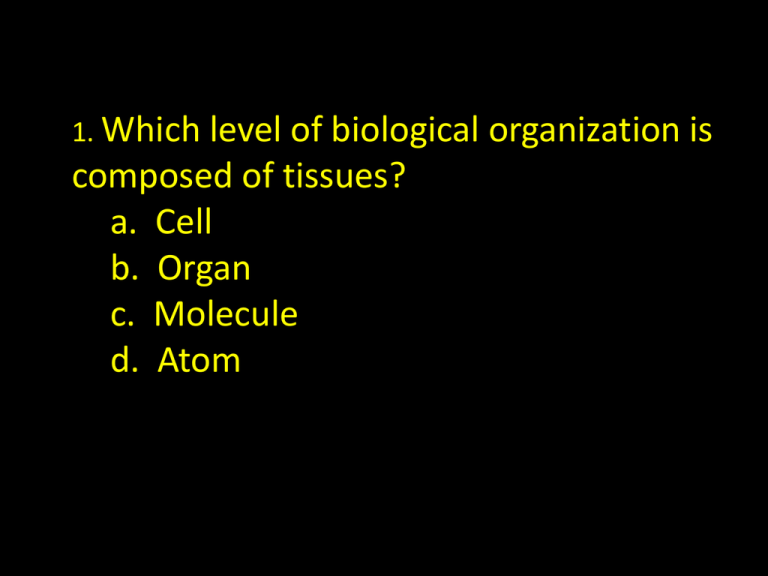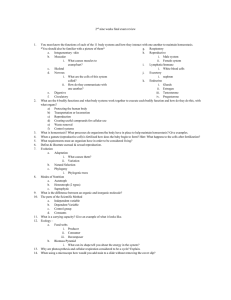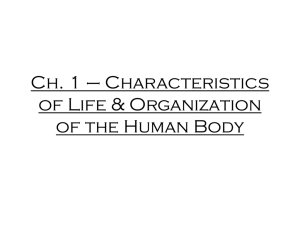Which level of biological organization is composed of tissues? a. Cell
advertisement

1. Which level of biological organization is composed of tissues? a. Cell b. Organ c. Molecule d. Atom b. Organ 2. Look at the pictures below of the cheetahs and the paramecium ( a single-celled organism). Then answer the question that follows. 2. Which of the following statements about the cheetahs and paramecium is false? a. These organisms respond to their environment. b. The cells of these organisms have the same basic structure. c. Homeostasis and metabolism are important for the cheetah but not for a paramecium. d. Reproduction means that the organisms will be able to produce more of their own kind. c. Homeostasis and metabolism are important for the cheetah but not for a paramecium. 3. We sent an unmanned spacecraft to another planet to detect other life forms that might be quite different from those on earth. If the probe can only send back one still picture, which property of life would be most evident? a. Organization b. Homeostasis c. Growth and development d. Response to stimuli a. organization. 4. The smallest unit that has all of the characteristics of life is the a. Cell b. Tissue c. Organ d. Organism a. Cell 5. Autotrophs obtain energy through ________________, while heterotrophs obtain energy through ___________________. a. photosynthesis, food eaten b. decomposition, reproduction c. food eaten, photosynthesis d. reproduction, decomposition a. photosynthesis, food eaten 6. Growth and/or development is not observed in the human organism during a. childhood b. adolescence. c. repair of an injury. d. death. d. death. 7. Which of the following is NOT an example of a response to a stimulus? a. A plant growing towards the sunlight. b. A caterpillar changing into a butterfly. c. The pupil of the eye changes in size with changes in light intensity. d. Stingers are discharged from the tentacles of a jellyfish when touched. b. A caterpillar changing into a butterfly. 8. Give one advantage each of sexual and asexual reproduction. Sexual: offspring has a mix of traits from both parents, so they are more diverse and may have a better chance of surviving changing conditions in the environment Asexual: Parent does not need to find a mate, which is helpful in an environment where there are few individuals of an particular species. 9. Using a butterfly as an example, compare and contrast the processes of growth and development. Growth involves an increase in the size of the organism or the number of cells, so when a butterfly grows, the length of its body may increase from 2-4 inches. Development involves a change in the form of an organism, so when a butterfly develops, they go from the caterpillar (larva) stage to the cocoon (pupa) stage to the adult stage (with wings). 10. Define homeostasis and give two examples of homeostasis in living things. Homeostasis means to maintain constant internal conditions regardless of the external environment. Two examples in living organisms include sweating to keep your body cool, and expelling wastes by going to the bathroom.






